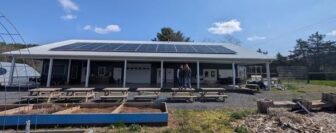We attended the Virginia Conservation Network-Va. League of Conservation Voters-Va. Garden Club training, Legislative Lobby Day 2008. The hall was crowded; about 300 people with a variety of conservation interests from all over the state attended, including half a dozen of our friends from up the road at the Williamsburg CAN.
(BTW, look beyond the roses before you pooh-pooh the Va. Garden Clubs; they are formidable–an extremely large, active, effective, and well-connected conservation group who are take quite seriously by the General Assembly.)
During the day we met with six Hampton Roads legislators or their legislative assistants during the day to express our support for many pending acts:(a complete list can be found on our site http://www.twcan.org/docs.cfm, ga2008.pdf ) 
- SB 446 Clean Energy Future Act; the Chesapeake Climate Action Network’s flagship bill bringing clean energy, clean jobs training and clean jobs to Virginia
- HB 650 Department of Environmental Quality; maintaining the 62-year history and authority of Virginia’s Citizens Boards.
- SB 625 Bipartisan Redistricting Commission; to stop the endless political gerrymandering of district lines and inserting some rational guidelines into the process
- SB 320 to end covenants restricting solar energy collection devices
- HB 153 Solar water heating system pay-as-you-save pilot program, to make solar hot water more affordable for more people.
We tried to keep our visits positive, but we felt compelled to strongly oppose:
- SB 525 Uranium mining act as inadequate. Instead of a 15-member, politically appointed commission, we suggested the state fund a scientific study by the National Science Foundation or National Academy of Sciences on the science of uranium mining in Virginia. Passage of this bill would break the decades long ban on uranium mining in Virginia. This is too important a question to be left to politicians and industry insiders. Science should guide policy.
- Here are some quick facts about uranium mining:
- with just a slight increase in acidity of the water, uranium deposits are highly water soluble material
- it takes 1-2 tons of ore to produce 1 lb of yellow cake uranium and of that only 1-2% is reactor quality material, that’s a lot of mine tailings
- this is a slurry process sure to produce acres of dammed radioactive sludge near our waterways and ground water sources
- the Pennsylvania county (Danville region) gets 44 inches of rain per year, increasing the likelihood of leeching or a dam break
- uranium mining has never been attempted in an area with such a large population
- the water shed from this region feeds both the Richmond (James River) and the Virginia Beach (Lake Gaston) water supplies.
This is a completely separate issue from the question of nuclear power generation. If you’ve seen pictures of the collapse of a dam holding back hundreds of acre-feet of coal slag tailings, imagine what it would be like with a radio active uranium slag.





